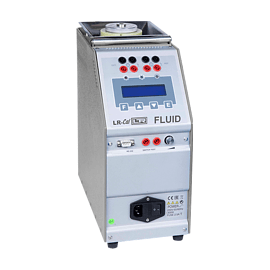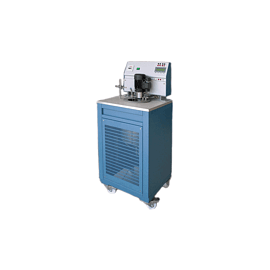Temperaturecalibration baths

Portable and stationary temperature calibration baths as controlled temperature source for temperature comparison calibrations
What is temperature calibration with a temperature calibration bath?
The test item (temperature measuring instruments of all types, e.g. dial thermometers, glass thermometers, resistance thermometers, temperature switches, thermostats, etc.) and the reference temperature measuring instrument (installed in the calibrator or external reference) are both subjected to test temperatures. The measured values of the reference are compared with the values of the test item. In this way, a statement can be made not only about the function of the test item, but also about the measurement accuracy or the measured value deviation of the test item.
Please note that the specifications regarding radial and axial temperature uniformity given in the respective technical data refer to specific immersion depths and do not necessarily apply to all immersion depths in every case. The temperature range specifications apply at an ambient temperature of +20°C.
The LR-Cal temperature calibration baths have an internal (built-in) reference. If its accuracy is not sufficient, an external reference (without or with its own display) can be used.
The LR-Cal temperature calibration baths (with the exception of the LR-Cal LTC 150/250-F(-PLUS) devices) are each available in two different versions. A basic version, as well as a version "-2I" with integrated measuring inputs for two temperature sensors (Pt 100 or thermocouple), e.g. one external reference sensor and one test item, or two test items. In this version, all three temperatures are displayed simultaneously: the measured value of the reference integrated in the calibrator and the measured values of the two externally connected sensors.
Furthermore, the LR-Cal AQ2sp2 PC software is available as an option for the LR-Cal temperature calibration baths. With this, the calibrator can be completely controlled from the PC via its serial interface, manual or automatic calibration of one or more DUTs, load and lifetime tests, thermostat tests, as well as the creation of calibration certificates.
Synonyms
Temperature calibration baths are also referred to as
- Calibration bath
- Micro bath
- Temperature bath
- Temperature calibrator
- Temperature calibration device
- Temperature calibration bath
Calibration liquids for LR-Cal temperature calibration baths
Applications:
- Thermostatic fluids for micro baths and thermostatic temperature calibration baths
Main Characteristics:
- Operating range -50...+200°C
- High stability
- Good thermal conductivity
- Nearly odourless
- Long service live
- Packaged in bottle or canister
- Different types for a wide range applications
- Low toxicity
- Low viscosity and corrosovity
Our thermostatic fluids are suitable for use in liquid thermostatic calibrators and thermostatic baths for applications from -50°C to +200°C.
The choice of thermostatic fluid is the most important aspect for obtaining the best results with regard to operation and temperature control of calibrators and baths.
These fluids have perfect thermodynamic characteristics to guarantee the best performance in the various fields of application, ensuring safe and reliable operation as well as optimum heat transfer efficiency.
Silicone-based fluids are chemically inert substances that do not affect metals, are resistant to weathering and, when used correctly, the very low formation of cracking and oxidation ensures a long service life.
Most of our thermostatic fluids are available in different containers: 500 cm³ bottles or 9 kg canisters (25 kg on request).
Temperature application ranges of the various operating fluids:
| Type of calibration medium (liquid) |
Usable range (1) |
Temperature above which fume hood should be provided (2) |
Fume burning (3) |
A viscosity of 10 cst exists at a temperature of (4) |
Freezing temperature (5) |
|---|---|---|---|---|---|
| Glycol 56% + water * | -40...+90°C | +70°C | >110°C | +20°C | -43°C |
| Silicone oil 47V5 | -40...+130°C | +110°C | +136°C | +5°C | -65°C |
| Silicone oil 47V10 | -30...+150°C | +120°C | +160°C | +20°C | -65°C |
| Silicone oil 47V20 | -20...+200°C ** | +130°C | +230°C | +60°C | -60°C |
| Silicone oil 47V50 | +30...+250°C ** | +140°C | +280°C | +160°C | -55°C |
| Silicone oil 47V100 | +50...+200°C ** | +170°C | >300°C | +200°C | -55°C |
| Silicone oil 47V150 | +50...+200°C ** | +190°C | >300°C | -/- | -55°C |
| Note: | Note text: |
|---|---|
| * | Mixture of 56% Glycol + 44% water |
| ** | In order to avoid gelling, it is recommended not to exceed a temperature of 200°C for a long time; even for fluids with wider operating ranges |
| (1) | Usable range The “usable range” of a calibration liquid is the temperature range in which it can be used under optimum conditions. The range may be limited by viscosity, flash points, freezing points, boiling points, evaporation rates, tendency to gel (or polymerize), etc. There is no liquid that covers extremely wide temperature ranges. Therefore, you should ideally use a separate calibration liquid for each temperature range. The recommended range is the one in which the viscosity is not optimal, but still reaches values that allow proper use. |
| (2) | Use of a fume hood The use of an exhaust hood when using temperature calibration baths prevents users from inhaling vapors from calibration liquids. It is best to use extraction devices near the access opening to the calibration bath. Vapors can otherwise settle on the mucous membranes of the eyes or on the skin, causing discomfort. Silicone oils can form benzene and formaldehyde when they decompose at high temperatures. The table shows the temperature above which an extractor hood should be used. |
| (3) | Flash point The table shows the temperature value at which the presence of an open flame can ignite vapours combustion. |
| (4) | Viscosity Viscosity is a measure of the flow resistance of a liquid. Viscosity increases with decreasing temperature. Kinetic viscosity is the ratio of absolute viscosity to density. This is measured in stokes and centistokes (cSt). 1 cSt = 1 stoke divided by 100. The higher the cSt, the more viscous or dense the liquid. Excessively viscous liquids place a strain on the stirring and pumping mechanisms of the calibration bath and do not transfer heat sufficiently. The table shows the temperature value below which the performance of the temperature calibration bath is no longer optimal. The equivalent value of water at 20°C is 1.1 cst. |
| (5) | Freezing point Silicone oils also change their state below a certain temperature by solidifying. The table shows the value at which the calibration fluid changes its state and solidifies. |
Other physical and chemical properties
Specific heat
The specific heat is the amount of heat required to raise or lower the temperature by 1 °C per kg. The specific heat, called CP, is expressed in Kcal/Kg °C. The energy required to heat or cool the calibration liquids depends on the amount of liquid contained in the calibrator in kg and its specific heat. A high specific heat value requires more energy to change the temperature, but offers greater temperature stability. The average CP of silicone fluids is 35 Kcal/Kg °C. The CP of water at 20 °C is equal to 1.
Thermal conductivity
Thermal conductivity is the ability of the liquid to transfer heat from one molecule to another. The better the heat transfer, the faster the liquid heats or cools. Better thermal conductivity improves the temperature uniformity in the reservoir of the calibration bath.
Expansion
All liquids have a coefficient of thermal expansion. This indicates how much the volume of a liquid changes (expands or contracts) when the temperature changes. Liquid expansion has an important impact on the safety, cleanliness and maintenance of temperature calibration baths. If calibrators are filled with too much liquid at a low temperature and then heated without regard to the increase in volume, they can overflow.
If too little liquid is filled in the reservoir, below the level of the heating elements, the temperature rise of the non-immersed part of the heating elements could ignite the liquid.
Gelation (polymerization)
The gelling temperature is the temperature at which silicone fluids oxidize, gel and turn into a viscous slurry. The main cause of this phenomenon is oxidation. Although silicone fluids can be used safely up to their flash point, the susceptibility to polymerization increases when used above their oxidation point. To prevent polymerization, it is advisable to keep the operating time above the oxidation point of the silicone oil used as short as possible in order to keep contaminants (salts, other oils and oxidizing agents) away. The calibration fluid must be replaced if it becomes dark, viscous or temperature unstable. It is important to limit the application time at high temperatures to prevent the oil from degrading and to extend its service life.


